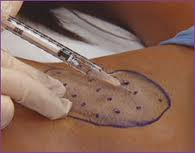Hyperhidrosis, defined as abnormally excessive sweating, can affect many areas of the body including the hands and feet, groin area and also the armpits. Hyperhidrosis affects about 3% of the U.S. population and is when the amountof sweat produced is much more than is needed to regulate body temperature. As a result it interferes with some activities of daily living and is a constant source of social embarrassment. The specific cause of this condition is unknown although approximately 30-50% of patients who suffer from it do have a genetic predisposition to it.
Hyperhidrosis is more severe in warmer weather and less severe in colder climates. One common complaint found in many patients with hyperhidrosis, regardless of the body area affected, is that they get nervous because they know they are excessively sweating, which in turn then causes the body to produce more sweat.
While topical treatments have been around for decades, the most potent and effective treatment is by injection. The Food and Drug Administration approved the use of Botox, OnabotulinumtoxinA, injections in 2004 to treat axillary hyperhidrosis (underarm sweating). These injections are recommended for use in adults, once a patient has tried other topical agents such as ointments, powders and sometimes even electrical stimulation therapies, with no to limited success. Examples of some treatments are aluminum chloride antiperspirants (prescription deodorants) and oral anticholinergic medications such as Oxybutynin (Ditropan) and Benztropine (Cogentin). All of these treatments aim to reduce axillary hyperhidrosis by treating the symptoms of the condition.

Botox may be just the alternative many people who suffer from the previously undiagnosed or misdiagnosed condition, are looking for without having to undergo surgery. In the clinical studies performed both in the United States and Europe to approve Botox as a treatment for axillary hyperhidrosis, patients found that they had improved quality of activities of daily living, such as changing their clothes less frequently throughout the day due to decreased sweating. What was once an embarrassing and somewhat debilitating condition has an FDA-approved treatment that is not only effective, but also minimally invasive.
Surgical options for axillary hyperhidrosis do exist and include excision and sweat gland removal/disruption using a variety of techniques. Excision works by removing axillary skin that contains the abnormal sweat glands. While very effective, it leaves a long scar that is prone to widening and can never remove all the affected skin given since it is rarely limited to what the excisional pattern can remove. Removing the sweat glands by various ablation techniques on the undeside of the skin has been done for years. It has most recently been advocated by using a fiberoptic laser probe (Smartlipo) to ‘burn’ the sweat glands by running it along the underside of the dermis of the skin. While advocated by some, I have found its effectiveness to be only temporary as it more likely disrupts the neural connections to the sweat glands rather than actually eliminating (melting) them.
The one axillary hyperhidrosis technique that I find most effective, old as it may be, is to open cautery of all hair bulbs that can be exposed without an excessively long axillary incision. Many sweat glands are aligned with hair follicles so cauterizing the black hair bulbs on the underside of the skin assures some permanent reduction in sweat output.

Dr. Barry Eppley
Indianapolis, Indiana


